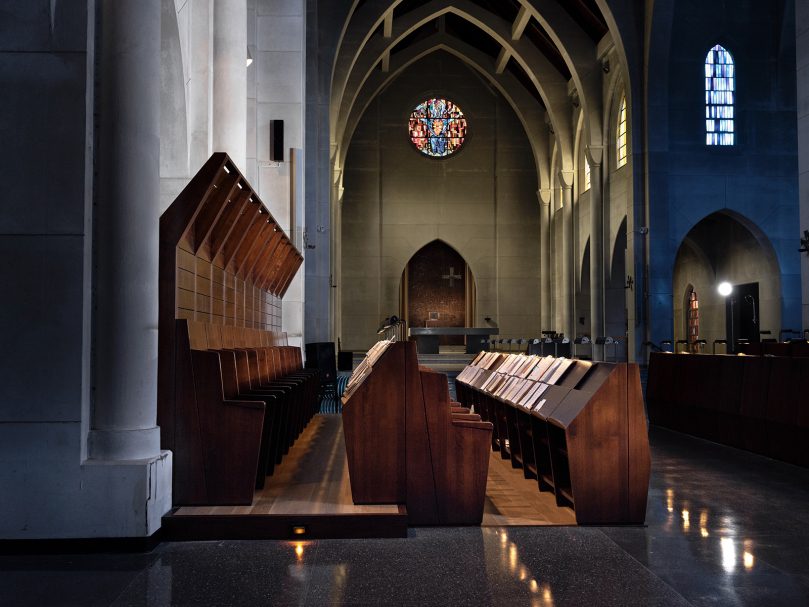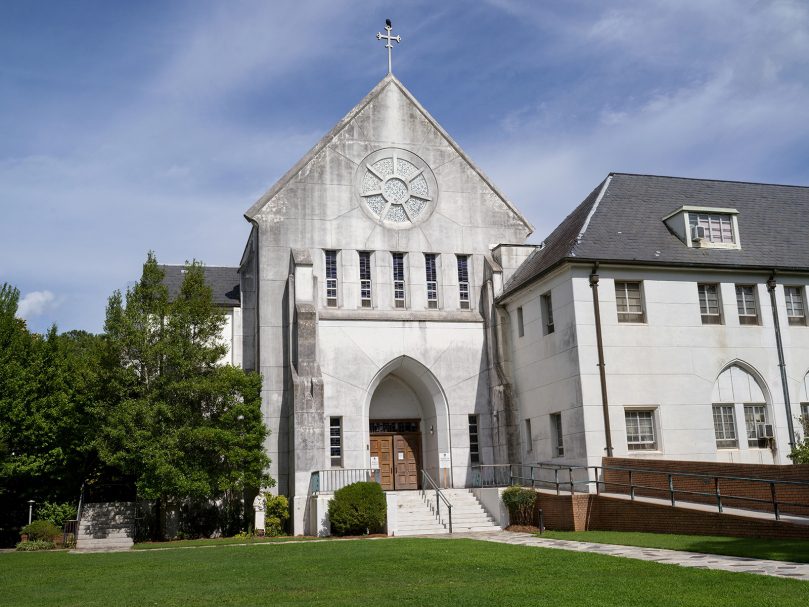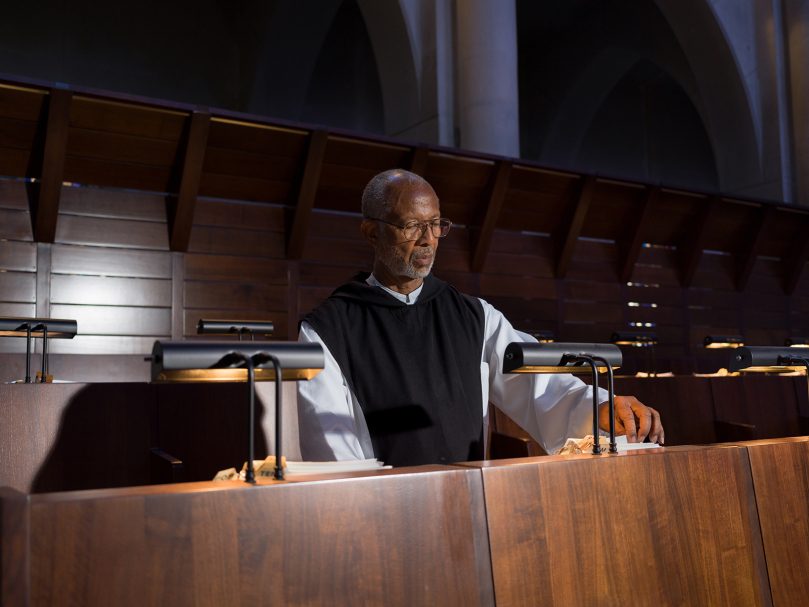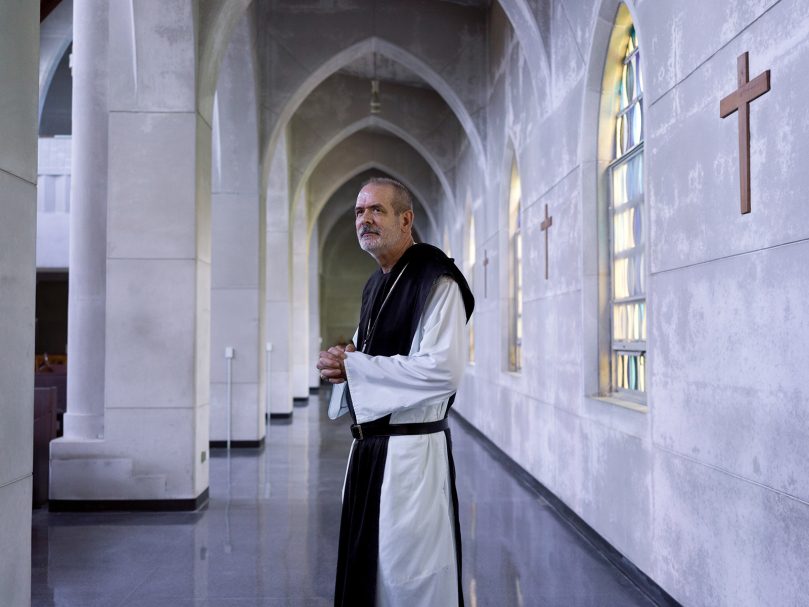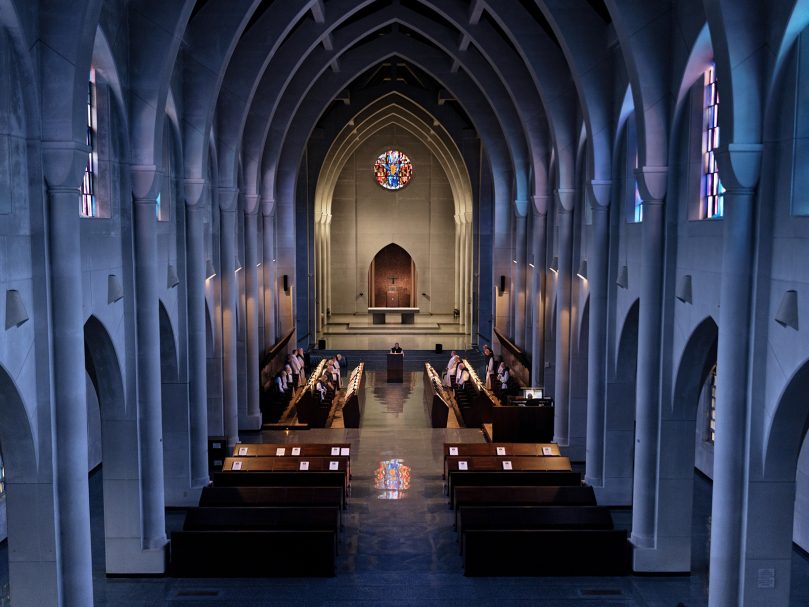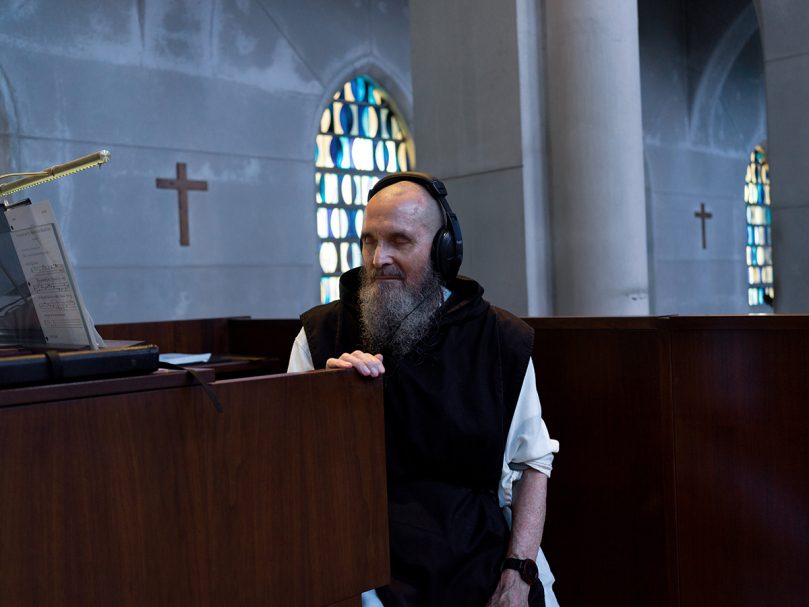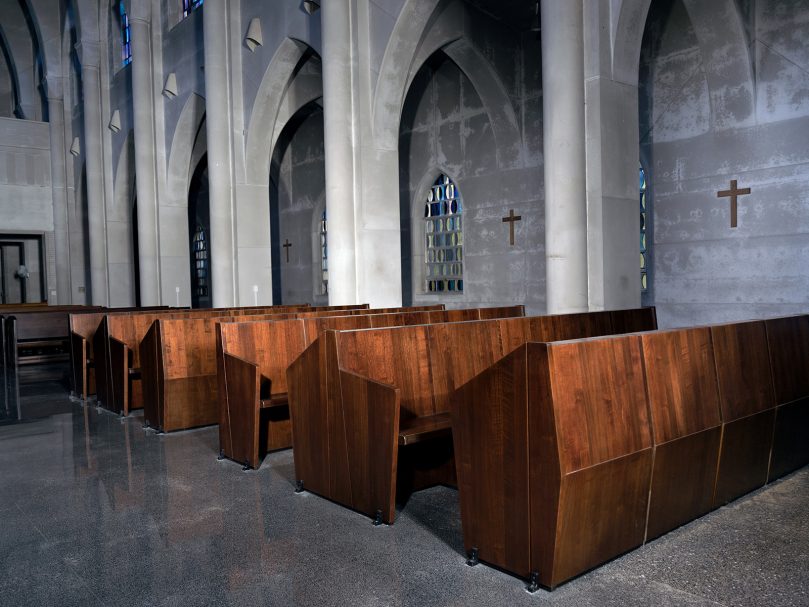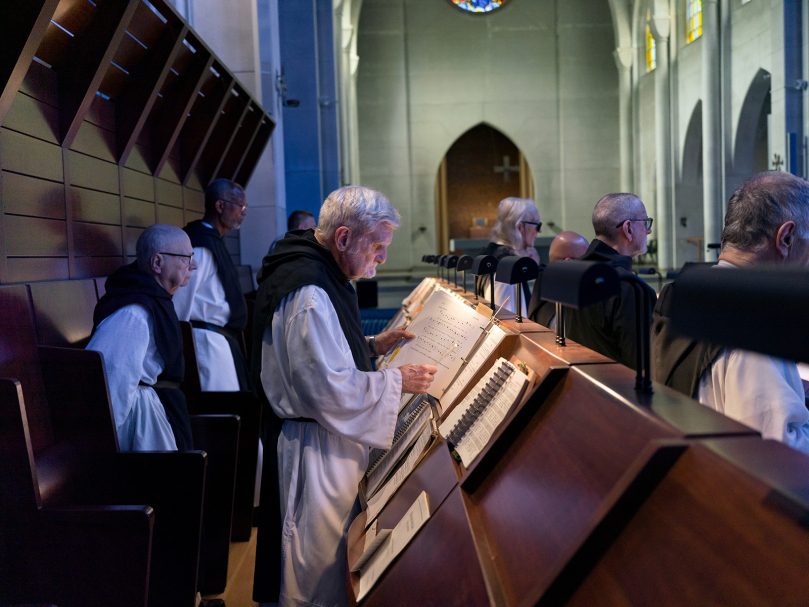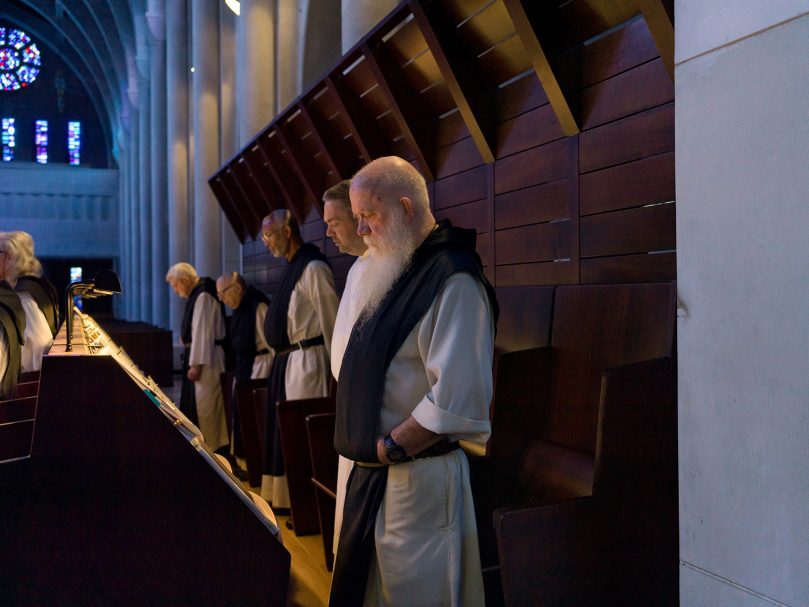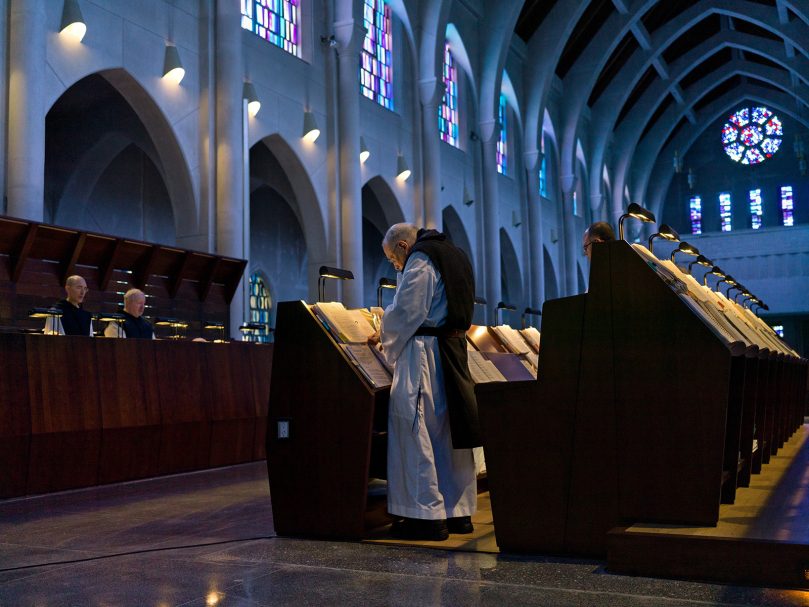Newly constructed choir stalls within the sanctuary of the Abbey Church are part of the renovation at the Monastery of the Holy Spirit in Conyers. Photo by Johnathon Kelso
Conyers
Monastery reopens renovated Abbey Church
By GRETCHEN KEISER, Special to the Bulletin | Published August 5, 2022
CONYERS—After more than two years of closure, the Monastery of the Holy Spirit community of Cistercian monks is reopening the Abbey Church to the public for prayer and Mass.
When visitors enter, they will find the soaring beauty of the white-arched church, with its shafts of pale blue and violet stained glass, shining with restoration and renovation.
More projects are underway to help visitors experience this prayer environment more deeply. A fund drive is also taking place to help complete these improvements.
The monks built the church themselves more than 60 years ago. The monastery was founded in 1944.
“We come now back into our sacred space. … We are grateful for the beauty of this space which we have inherited and which we believe we now have enhanced,” Abbot Augustine Myslinski said at vespers July 10. “May we consecrate ourselves more deeply to prayer for ourselves, our community, and for the life and salvation of all the world.”
Like everyone else, the pandemic abruptly changed daily life for the monks.
On March 13, 2020, when the Atlanta Archdiocese closed its churches temporarily because of the spread of COVID-19, the abbot closed the abbey church and other public buildings.
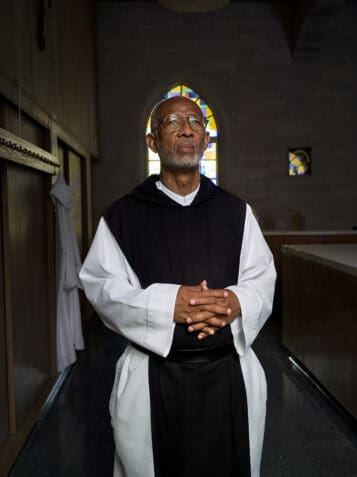
Brother Callistus Crichlow, OCSO, is photographed inside the sacristy at the Monastery of the Holy Spirit in Conyers July 25. Photo by Johnathon Kelso
The community is grateful that all the 25 monks living there are healthy and have been protected so far from contracting the virus. They just received their second boosters of the vaccine.
“Although it was difficult, and we had to stumble through it, we were so protected,” Brother Callistus Crichlow, monastery cellarer, said. “We shut the place down completely. The abbot was very protective—no one in, no one out.”
Their monastic silence and solitude became even more so with virtually no public contact, said Abbot Augustine. Most of the monks embraced the greater quiet, he said.
“We experienced each other a little bit more. There were fewer distractions of appointments, of people coming in and out of the church. We embraced the greater sense of silence that we had here, and solitude.”
At the same time, “we were concerned about what was happening in the world,” he said. “Many people come here with heavy hearts. … They were the group I was most concerned about.”
Because of this, the grounds were kept open during the pandemic and when later possible, the church was left open for people to stop in without the monks present.
But while closed to the public, the community took the time to have reflection, discernment and interior work, both physical and spiritual. Most visibly, they decided to push forward with renovations that were needed and planned for the church despite pandemic obstacles.
Updates and improvements
The existing choir stalls—banks of seating where the monks pray the Liturgy of the Hours—were removed and replaced with new choir stalls built of black walnut that are designed to enhance the acoustics of the monastic chants. A band shell feature extends overhead. Support and flooring underneath were redone, as was the lighting for the area. Daily prayer begins at 4 a.m. and compline is prayed at 7:30 p.m. so the church is often dark.
The old plywood choir stalls, built in the 1960s, were intended to be temporary, but until now were never replaced.
The choir stalls face each other across the main aisle of the church. During the Liturgy of the Hours, the psalms are prayed with monks on one side chanting verses and monks on the other side responding in chanting the next verses until the psalm is completed.
The acoustical improvements will make the prayer chanted better heard and enhance this ancient form of worshiping God, which takes place seven times a day.
“It is built in such a way that it enhances praise to God through song,” Brother Callistus said.
The monks began praying in the new choir stalls on July 10, the vigil for the feast day of St. Benedict, whose rule of life they follow.
“I am very pleased and I think most of the brothers are,” the abbot said, adding that he appreciates the sound and the substantial nature of the new choir stalls. He also thinks they add to the beauty of the church.
To his eye their design has a beautiful symmetry with the shape of the vaulted ceiling, seeming to blend in with the arches high above.
“When I am celebrating Mass and looking the other way, it is beautiful too,” he said.
They were made on the monastery grounds by a master craftsman who had done work for a Cistercian monastery in California, assisted by other carpenters. Fortunately, the project was initiated before the pandemic and the monks already had the wood on hand.
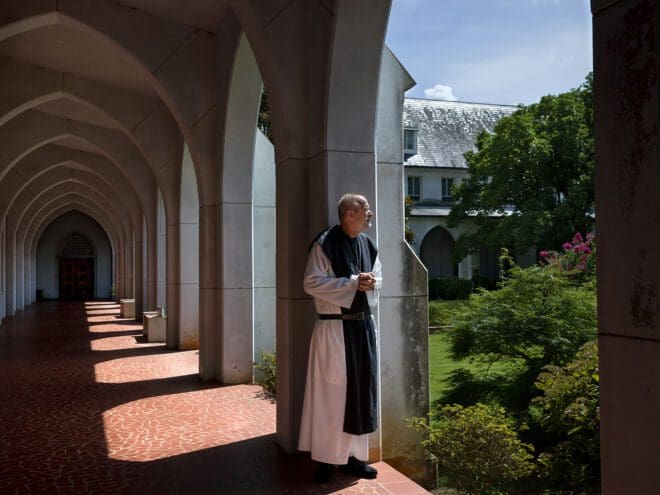
Abbot Augustine Myslinski, OCSO, is photographed on the grounds of the Monastery of the Holy Spirit in Conyers, which is reopening the Abbey Church after two years of closure. Photo by Johnathon Kelso
In addition, new pews have been crafted and installed for those who come to the monastery for retreats and the lay Cistercian community. These pews face the altar and have a slanted pedestal to display the readings and hymns for the Liturgy of the Hours. There is seating for 40 or more people.
There are also additional pews for people coming to Mass who are not on retreat.
The terrazzo floor in the church has been cleaned and restored, with some new flooring added as pews were relocated. All the stained glass windows in the church were cleaned, inside and out, a job the abbot said he did himself.
About a decade ago, the monastery embarked on a significant renewal, affecting the industries that keep the monks self-supporting, and also the grounds and public buildings. One goal was to invite the public into a deeper understanding of monastic life, while protecting the solitude of the monks. The Monastic Heritage Center was built in an historic barn.
Renovation with focus
This renovation is focused on the heart of the monks’ life, their communal prayer.
“We wanted to do something for ourselves, something that will enhance and deepen our prayer experience,” the abbot said.
Living the monastic life with holiness means having the proper disposition of the heart while carrying out the Rule of St. Benedict in its wisdom regarding the balance of work and prayer.
Enhancements to the church are meant to lead those who have given their lives over to this monastic life to an interior disposition of prayer.
The abbot told the monks at Mass on July 11, “The genius of Benedict, we know, was … to help the common man live the monastic life. Let’s face it, that is us. … We don’t come to the monastery because we are holy but because we seek it and desire it.”
For those who have come to the church in the past, a significant change is the addition of air conditioning and humidity control to preserve the newly crafted stalls and pews. Already, large flexible tubing is cooling the church, while engineers evaluate how to make a permanent air conditioning and heating system.
A new sound system is being installed to help visitors hear the readings, prayers and homilies.
The addition of two new bathrooms near the church entrance for use by the general public is also planned.
A fund drive is underway, asking people to help with the completion of the projects. An estimated 80,000 people visit the monastery each year. The drive is seeking to raise $3.4 million, and about $800,000 has been donated during an initial phase.
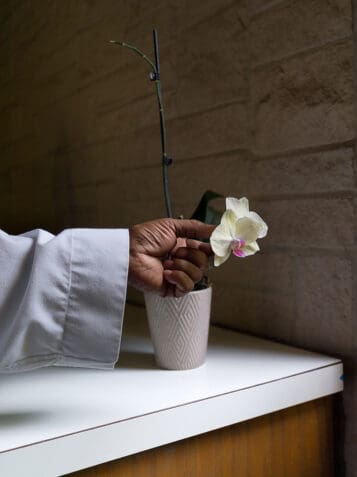
Brother Callistus Crichlow, OCSO, holds an orchid ahead of a July 25 vespers service at the Monastery of the Holy Spirit. Photo by Johnathon Kelso
During the closure, the community considered making liturgical changes in the church, according to Brother Callistus, who is serving as cellarer, the monk responsible for the physical aspects of the monastery.
With the guidance of the abbot of Gethsemani Monastery in Kentucky, they considered relocating the altar between the monks’ choir stalls and the visitor pews. This would bring both the monks and the people around the altar at the offertory of the Mass.
The monks placed a temporary altar there during the pandemic and experienced this change but decided the original location in front of the monastic choir stalls was deeply ingrained in the community and its many visitors, Brother Callistus said.
“It was a good exercise,” he said, adding that he originally liked the proposal but then came to a realization to affirm the original location through the community discernment process. “It came gradually to each of us by the Holy Spirit, ‘This is who we are,’” he said.
“We decided to refurbish and enhance what our original founding monks gave us. They gave us this beautiful sanctuary that was built by the monks. We feel it is our duty to honor them by preserving what they gave us and enhancing it to accommodate the present time, the 21st century.”
“When it was built, there was no concern for bathrooms, no concern for lights. It was built only for the monks. We found we had to renovate in order to accommodate, to address our present day worshippers, our present day visitors by being more open—gladly so—post-Vatican II,” Brother Callistus said.
It was also a graced time to look at their industries and their community, he said.
“It gave us the opportunity to really think through a lot of things. … We were able to look at every industry and every problem that we had in the monastery, one by one.”
Among the decisions was closing the bonsai greenhouse and garden shop. The Abbey Store reopened last November and is refocused on religious articles, books on prayer, meditation and contemplation and the food gifts made at the Conyers monastery or at other Trappist communities. The monks continue to make fudge, biscotti and fruitcake.
The conservation burial ground on monastery property, known as Honeycreek Woodlands, was open throughout the pandemic and is doing very well.
Closing the bonsai industry “was a thoughtful decision based on evidence of the income there. It wasn’t making any money. … Bonsai was a good monastic industry. It fit in with who we are. It is contemplative. We miss that,” the abbot said.
“The cemetery fits in with us too. It is quiet. It is beautiful. People are drawn to come here to the monastery. It is sacred ground. They feel much better having their loved ones buried here. This has peacefulness, with hope.”
Virtual retreats are being offered, but in-person retreats will begin Aug. 16.
“The brothers did very well in the process. It was a long process. The brothers were patient. I think they are happy with the outcome,” the abbot said.
For about a year and a half, all the liturgical prayer of the community took place in a temporary chapel set up inside the cloister chapter room.
Two men have been accepted as novices in the community and three monks made their solemn profession of vows in the last six years, the abbot said. The community in May elected Abbot Augustine to a second six-year term as abbot.
Preaching to the community on the feast of St. Benedict, the abbot prayed, “May our liturgical life in this renovated church be simple and modest, yet deep and heartfelt. May it overflow into our life in community, a life of simplicity and moderation in ‘ora et labora’ (prayer and work).”
More information can be found at trappist.net or by calling 770-483-8705.
